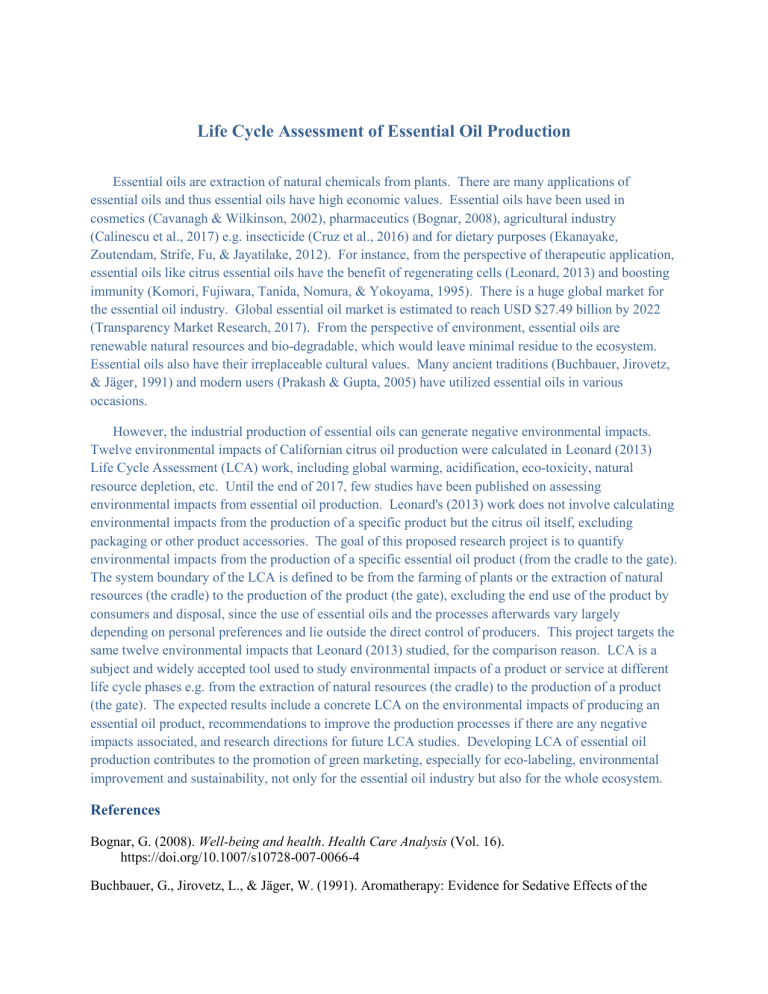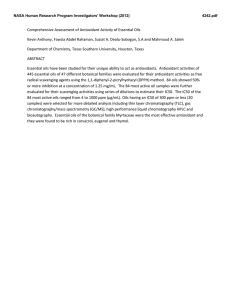
Life Cycle Assessment of Essential Oil Production Essential oils are extraction of natural chemicals from plants. There are many applications of essential oils and thus essential oils have high economic values. Essential oils have been used in cosmetics (Cavanagh & Wilkinson, 2002), pharmaceutics (Bognar, 2008), agricultural industry (Calinescu et al., 2017) e.g. insecticide (Cruz et al., 2016) and for dietary purposes (Ekanayake, Zoutendam, Strife, Fu, & Jayatilake, 2012). For instance, from the perspective of therapeutic application, essential oils like citrus essential oils have the benefit of regenerating cells (Leonard, 2013) and boosting immunity (Komori, Fujiwara, Tanida, Nomura, & Yokoyama, 1995). There is a huge global market for the essential oil industry. Global essential oil market is estimated to reach USD $27.49 billion by 2022 (Transparency Market Research, 2017). From the perspective of environment, essential oils are renewable natural resources and bio-degradable, which would leave minimal residue to the ecosystem. Essential oils also have their irreplaceable cultural values. Many ancient traditions (Buchbauer, Jirovetz, & Jäger, 1991) and modern users (Prakash & Gupta, 2005) have utilized essential oils in various occasions. However, the industrial production of essential oils can generate negative environmental impacts. Twelve environmental impacts of Californian citrus oil production were calculated in Leonard (2013) Life Cycle Assessment (LCA) work, including global warming, acidification, eco-toxicity, natural resource depletion, etc. Until the end of 2017, few studies have been published on assessing environmental impacts from essential oil production. Leonard's (2013) work does not involve calculating environmental impacts from the production of a specific product but the citrus oil itself, excluding packaging or other product accessories. The goal of this proposed research project is to quantify environmental impacts from the production of a specific essential oil product (from the cradle to the gate). The system boundary of the LCA is defined to be from the farming of plants or the extraction of natural resources (the cradle) to the production of the product (the gate), excluding the end use of the product by consumers and disposal, since the use of essential oils and the processes afterwards vary largely depending on personal preferences and lie outside the direct control of producers. This project targets the same twelve environmental impacts that Leonard (2013) studied, for the comparison reason. LCA is a subject and widely accepted tool used to study environmental impacts of a product or service at different life cycle phases e.g. from the extraction of natural resources (the cradle) to the production of a product (the gate). The expected results include a concrete LCA on the environmental impacts of producing an essential oil product, recommendations to improve the production processes if there are any negative impacts associated, and research directions for future LCA studies. Developing LCA of essential oil production contributes to the promotion of green marketing, especially for eco-labeling, environmental improvement and sustainability, not only for the essential oil industry but also for the whole ecosystem. References Bognar, G. (2008). Well-being and health. Health Care Analysis (Vol. 16). https://doi.org/10.1007/s10728-007-0066-4 Buchbauer, G., Jirovetz, L., & Jäger, W. (1991). Aromatherapy: Evidence for Sedative Effects of the Essential Oil of Lavender after Inhalation. Zeitschrift Für Naturforschung C, 46(11–12), 1067–1072. https://doi.org/10.1515/ZNC-1991-11-1223 Calinescu, I., Asofiei, I., Ionuta Gavrila, A., Trifan, A., Ighigeanu, D., Martin, D., … Buleandra, M. (2017). Integrating Microwave-Assisted Extraction of Essential Oils and Polyphenols from Rosemary and Thyme Leaves. https://doi.org/10.1080/00986445.2017.1328678 Cavanagh, H. M. A., & Wilkinson, J. M. (2002). Biological activities of Lavender essential oil. Phytotherapy Research, 16(4), 301–308. https://doi.org/10.1002/ptr.1103 Cruz, G. S., Wanderley-Teixeira, V., Oliveira, J. V., Lopes, F. S. C., Barbosa, D. R. S., Breda, M. O., … Teixeira, A. A. C. (2016). Sublethal Effects of Essential Oils From Eucalyptus staigeriana (Myrtales: Myrtaceae), Ocimum gratissimum (Lamiales: Laminaceae), and Foeniculum vulgare (Apiales: Apiaceae) on the Biology of Spodoptera frugiperda (Lepidoptera: Noctuidae). Journal of Economic Entomology, 109(2), 660–666. https://doi.org/10.1093/jee/tow005 Ekanayake, A., Zoutendam, P. H., Strife, R. J., Fu, X., & Jayatilake, G. S. (2012). Development of white mustard (Sinapis alba L.) essential oil, a food preservative. Food Chemistry, 133, 767–774. https://doi.org/10.1016/j.foodchem.2012.01.090 Komori, T., Fujiwara, R., Tanida, M., Nomura, J., & Yokoyama, M. M. (1995). Effects of Citrus Fragrance on Immune Function and Depressive States. Neuroimmunomodulation, 2(3), 174–180. https://doi.org/10.1159/000096889 Leonard, J. (2013). Life Cycle Assessment - Renewable and Sustainable Citrus Oils. Retrieved from https://conference.ifas.ufl.edu/citrus10/Presentation PDFs/Wednesday/1120 Leonard.pdf Prakash, P., & Gupta, N. (2005). THERAPEUTIC USES OF OCIMUM SANCTUM LINN ( TULSI ) WITH A NOTE ON EUGENOL AND ITS PHARMACOLOGICAL ACTIONS : A SHORT REVIEW. Indian J Physiol Pharmacol, 49(2), 125–131. Retrieved from http://ijpp.com/IJPP archives/2005_49_2/125-131.pdf Transparency Market Research. (2017). Global Essential Oil Market will Reach USD 27.49 Billion by 2022: Transparency Market Research. Retrieved January 9, 2018, from https://globenewswire.com/news-release/2017/09/29/1134727/0/en/Global-Essential-Oil-Marketwill-Reach-USD-27-49-Billion-by-2022-Transparency-Market-Research.html



